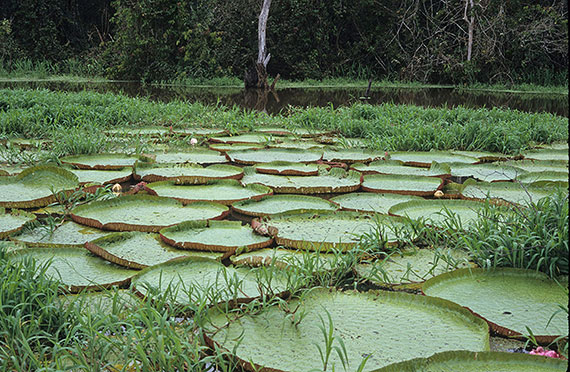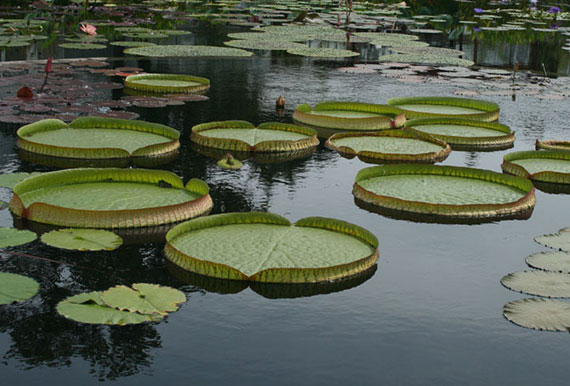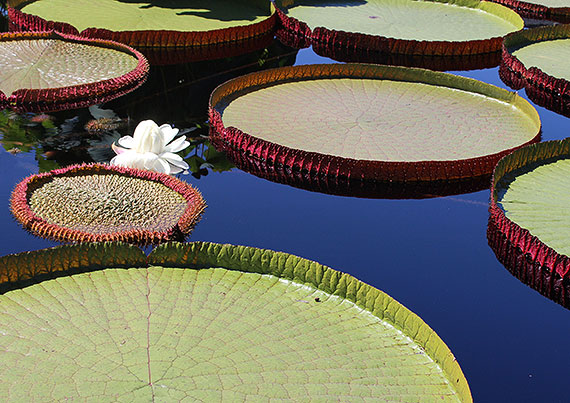Queen of the Amazon
Posted in Interesting Plant Stories on August 13, 2014 by Scott Mori
Scott A. Mori, Ph.D., is the Nathaniel Lord Britton Curator of Botany at The New York Botanical Garden. Francisca Coelho is the Vivian and Edward Merrin Vice President for Glasshouses and Exhibitions.

In a post on Plant Talk, Scott described the fascinating life cycle of the Amazon water lily. But how did this iconic Amazonian species receive its scientific name, and how did this popular late-summer attraction come to be cultivated so far from its native habitat at major botanical gardens such as The New York Botanical Garden?
The Amazon water lily was discovered by Eduard Friedrich Poeppig in Peru and, because he thought it was related to an eastern Asian water lily belonging to the genus Euryale, he named it Euryale amazonica in 1836. The species was rediscovered by the German botanist Robert Hermann Schomburgk on a botanical expedition supported by Great Britain to what was then known as British Guiana. Schomburgk shipped his detailed notes, drawings, and collections to the Royal Botanic Gardens, Kew, where John Lindley described the species as Victoria regia in 1837 in honor of Queen Victoria.
Even at that time, it was generally accepted that the first species epithet given to a newly discovered plant has priority over later names. Thus the first species epithet “amazonica” was transferred to Victoria by James Sowerby in 1850; thus, the correct name for the Amazon water lily is Victoria amazonica (Poepp.) J. C. Sowerby. Credit is given to Poeppig for discovering the species and to Sowerby for transferring the name to the currently accepted genus.
A second species, Victoria cruziana, was discovered in Bolivia and published by Alcide d’Orbigny in 1840. It differs from V. amazonica in its more southern distribution, greater tolerance for cold, and the higher rim around the circumference of the leaf. In addition, the underside of its leaf is green instead of red; its ovary is also green instead of red; it has a greater number of staminodes; and its seeds are round instead of oval and larger than those of V. amazonica.

at The New York Botanical Garden
The hybrid between V. amazonica and V. cruziana has hybrid vigor and produces more and larger flowers, but the vigor diminishes in plants germinated from seeds produced by hybrids. Therefore, the best display plants are grown from first-generation hybrid seed. One of the best sources for hybrid seeds is Longwood Gardens, and the cross is rightfully named Victoria ‘Longwood Hybrid.’ These crosses are made using Victoria amazonica as the pollen donor.
The seeds are gathered at the end of the growing season and are placed in a cool, dark place until the seed coat turns brownish-black. They are then put in distilled water at 45 degrees Fahrenheit until early February, when the seeds are moved to moist sand to germinate. By April, the seedlings have young leaves, and at the end of May the seedlings are moved to heated outdoor pools to temperatures approximating their native habitat. The leaves grow at the astonishing rate of four to 24 inches every 24 hours, and by late summer the plants are in full flower.
This year, the Amazon water lilies in the Conservatory’s tropical pool are Victoria ‘Longwood Hybrid’ and Victoria cruziana. V. cruziana tolerates cooler temperatures better than V. amazonica, making it a good choice this year since the summer has been cooler than normal so far.

To learn more about all aspects of the Amazon water lily, we recommend Tomasz Anisko’s book Victoria the Seductress, one of the most complete books ever written about a single species of plant.


Do you mind if I quote a few of your posts as long as I provide credit and sources back to your website? My website is in the exact same niche as yours and my users would definitely benefit from some of the information you provide here. Please let me know if this alright with you. Thanks a lot!